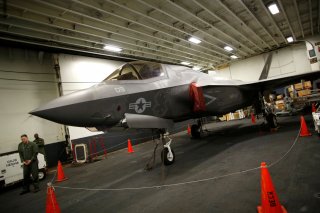Not Stealth Fighters or Super Weapons: The 1 Thing That Will Determine If America Wins the Next War
America making sure it will be ready if anything ever happens.
If one were to simply pose the question as to what word, term or series of words might best capture thoughts about what will define the future of war, one answer could easily be “command and control.”
After all, this is the information age, and the term command and control can encompass AI-enabled sensors, the computers that analyze and transmit information, weapon-to-target networking and finding ways to massively shorten “sensor-to-shooter” time.
“Connecting all sensors to all shooters through command and control nodes will be the basis for what we are going to do in the future,” General James Holmes, Commander, Air Combat Command, told retired Lieutenant General David Deptula, Dean of the Mitchell Institute for Aerospace Studies, in an interview.
This concept, placing information itself as indispensable connective tissue to networked cross-domain warfare, is developed by Deptula in a Mitchell Institute policy paper called Evolving Technologies and Warfare in the 21st Century: Introducing the Combat Cloud.
This “combat cloud” concept, when it comes to technical application, involves a fundamental shift toward using information itself as a principle weapon in warfare operations. The tactical use of information to organize and enable effective combat involves a range of tactics. These include using air-assets as “nodes” across a larger air-ground combat scheme, firing ground weapons to attack enemy air defenses and leveraging the altitude and range of surveillance aircraft to pinpoint targets for land-based attacks. For instance, a B-2 bomber or F-35 would not only function as an enabling attack platforms but also as their own sensor node to acquire, organize and distribute data.
“The F-35 has tremendous radar, radar maps and automatic target recognition to determine a threat better than a pilot could with a naked eye,” Holmes said.
With a combat cloud-type of concept, such as that entertained by Holmes and Deptula, there comes a need to properly prioritize, manage and distribute the most critical information at the right time. Not every shooter, for instance, will need full and immediate access to every sensor, yet data organized by AI-enabled algorithms can help an individual shooter receive the best and most relevant information.
“If all we did was increase the connectivity aspect through every echelon to report back up all the way to a multi-domain command center, we would not be fast enough to win,” Holmes said.
Holmes explained this as having an ability to network virtually all nodes, before making sure to empower those on the edge of combat with the ability to make fast-needed decisions in combat.
“We want to provide Commander’s intent across the Command and allow Wing Commanders to exercise authority, because they have the best view of the ground. You need people who are empowered out on the ends to take action based on the available information,” Holmes explained.
Kris Osborn is the defense editor for the National Interest. Osborn previously served at the Pentagon as a Highly Qualified Expert with the Office of the Assistant Secretary of the Army—Acquisition, Logistics & Technology. Osborn has also worked as an anchor and on-air military specialist at national TV networks. He has appeared as a guest military expert on Fox News, MSNBC, The Military Channel, and The History Channel. He also has a Masters Degree in Comparative Literature from Columbia University.
Image: Reuters

